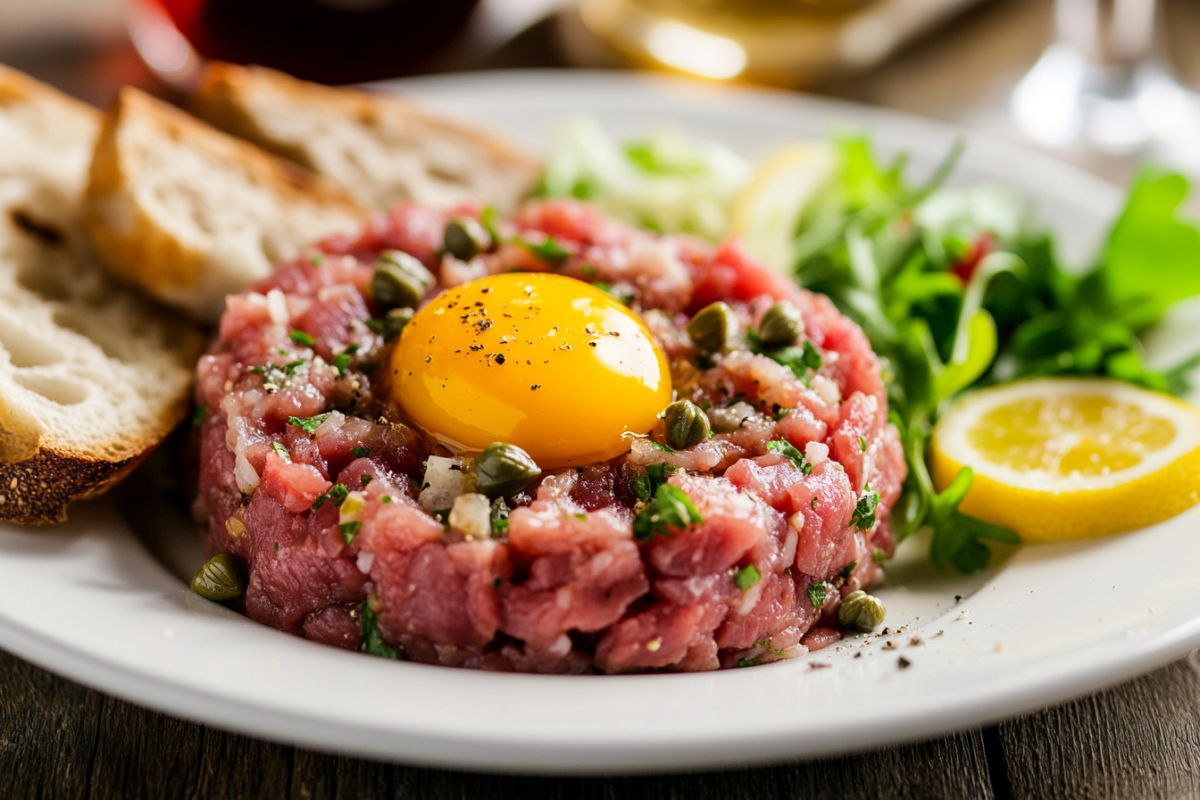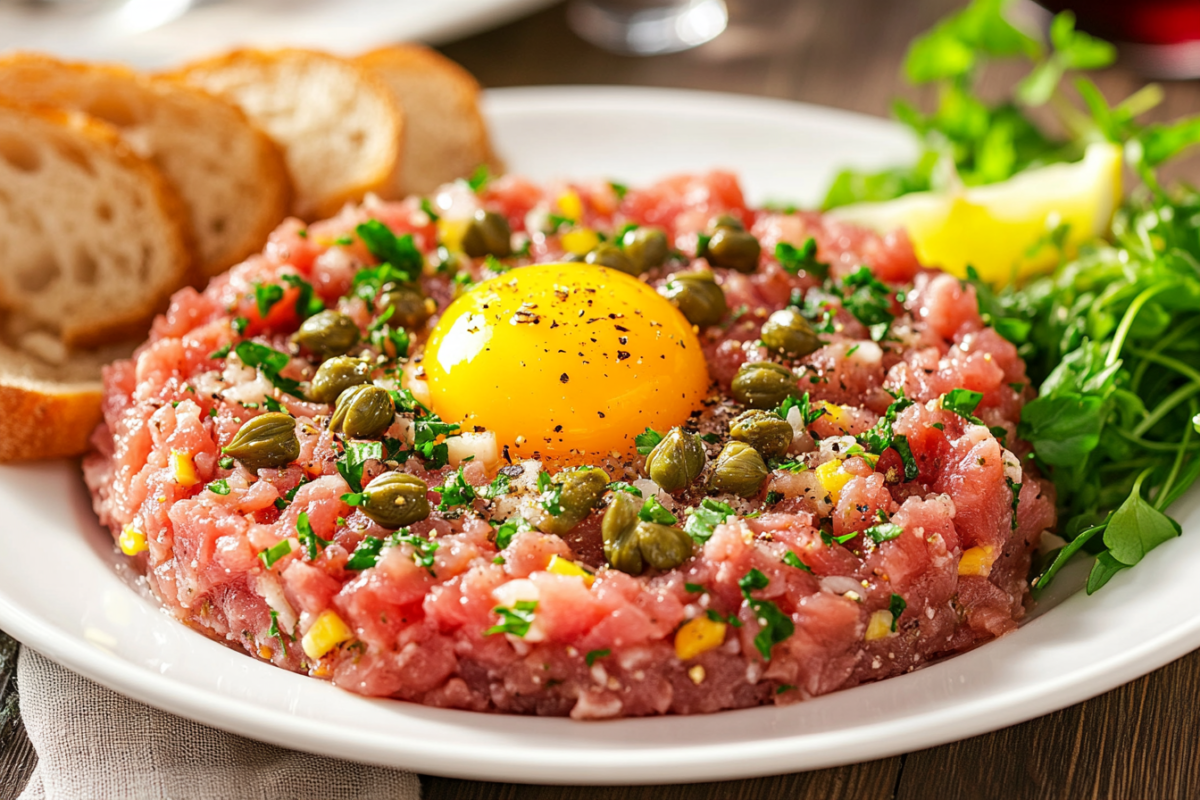Beef tartare is a classic French delicacy that has captured the hearts of food enthusiasts worldwide. Known for its unique flavor profile and fresh, quality ingredients, this raw meat dish is a culinary masterpiece. Whether you’re a fan of gourmet dining or looking to try something adventurous, beef tartare offers a one-of-a-kind experience. In this article, we’ll explore everything about this dish, from its origins to preparation, variations, and safety tips. Let’s dive into the world of beef tartare!
Introduction to Beef Tartare
What is Beef Tartare?
Beef tartare, often called a raw meat delicacy, is a dish made from finely chopped or minced raw beef, blended with seasonings and served cold. It’s a staple in upscale restaurants, known for its rich flavors and tender texture. This dish is typically garnished with a raw egg yolk and paired with crispy bread or salad.
History and Origins of Beef Tartare
The origins of beef tartare can be traced back to European culinary traditions. Its name comes from the Tatars, nomadic tribes who reportedly softened raw meat under their saddles during long journeys. Over time, the recipe evolved into the refined French dish we know today. Its introduction to fine dining menus solidified its status as a gourmet delight.
Why Beef Tartare is a Culinary Delicacy
Beef tartare is beloved for its sophisticated simplicity. The focus on high-quality ingredients, precise preparation, and artistry in presentation elevates this dish to a culinary work of art. Its combination of raw beef, tangy seasonings, and creamy egg yolk creates a balance of flavors that’s hard to resist.
What is Beef Tartare Made Of?
Beef tartare is a dish where simplicity meets sophistication, and each ingredient plays a crucial role in creating the perfect flavor and texture. Let’s break down the core components and why ingredient quality is paramount for this raw meat delicacy.
Core Ingredients
High-Quality Raw Beef
The star of beef tartare is undoubtedly the beef itself. Opt for fresh, high-quality cuts such as tenderloin or sirloin, known for their tenderness and flavor. Avoid pre-packaged ground beef, as the texture and freshness can compromise the dish.
Egg Yolk
Sitting like a crown atop the beef, the raw egg yolk adds a creamy richness to the dish. Its velvety texture binds the ingredients, creating a harmonious blend of flavors.
Seasonings: Salt, Pepper, Dijon Mustard, and Capers
Seasonings are where the magic happens. A pinch of sea salt enhances the beef’s natural flavors, while freshly ground pepper adds a subtle kick. Dijon mustard brings a tangy depth, and capers contribute a delightful brininess.
Optional Additions: Onions, Pickles, and Herbs
For those who enjoy a touch of customization, diced onions, finely chopped pickles, or fresh herbs like parsley can elevate the flavor profile. These additions provide a contrasting crunch or burst of freshness to complement the beef.
The Importance of Ingredient Quality
Why Freshness is Key for Raw Beef
Since beef tartare is served raw, freshness is non-negotiable. Fresh beef not only ensures the best flavor but also minimizes health risks. Look for beef that’s bright red with no discoloration or off-putting odors.
Choosing Organic and Sustainable Options
Whenever possible, choose organic or grass-fed beef. These options are free from additives and are generally more flavorful. Supporting local and sustainable farms also ensures a higher level of quality and care in production.
How to Prepare Beef Tartare at Home
Preparing beef tartare at home can seem intimidating, but with the right ingredients and a bit of patience, you can create a restaurant-quality dish. In this section, we’ll walk you through the step-by-step process of making this raw beef delicacy and offer helpful tips to ensure the perfect result every time.

Step-by-Step Guide
1. Preparing the Meat: Selection, Trimming, and Dicing
The first step in making beef tartare is selecting the right cut of beef. Opt for tenderloin, sirloin, or flank steak—these cuts are known for their tenderness and flavor. Start by trimming away any fat, sinew, or connective tissue. You want the meat to be as clean as possible for a smooth texture.
Once the meat is trimmed, cut it into small cubes using a sharp knife. For the perfect tartare texture, the cubes should be about the size of small peas. If you’re in a hurry, you can pulse the meat a few times in a food processor, but chopping it by hand ensures a better texture and more control over the size of the pieces.
2. Creating the Seasoning Mixture
Now that your beef is ready, it’s time to prepare the seasoning mixture. In a small bowl, combine Dijon mustard, salt, pepper, and capers. Some people like to add Worcestershire sauce or a dash of hot sauce for extra depth. The key here is balance—taste and adjust the seasoning until the flavors are just right.
You can also add finely chopped shallots, pickles, or fresh herbs like parsley or chives to enhance the flavor and texture. Remember, the seasonings should complement the beef, not overpower it.
3. Assembling the Dish: Plating and Presentation
When it comes to plating, presentation matters. Start by placing your prepared beef mixture in the center of a chilled plate or a shallow bowl. Use a ring mold for a neat, professional look. Then, gently press the beef into the mold, making sure it holds its shape.
Top your beef tartare with a raw egg yolk placed carefully in the center. Garnish with fresh herbs, a sprinkle of capers, or finely diced onions for a burst of color and flavor. Serve with crispy toast or baguette slices on the side to scoop up the tartare. If you prefer, you can serve it with a side salad or some crunchy vegetables to add a refreshing contrast to the rich beef.
Kitchen Equipment Needed
Making beef tartare doesn’t require many special tools, but there are a few essentials that will make the process easier:
- Sharp Knife: A good, sharp knife is a must for dicing the beef cleanly and evenly.
- Cutting Board: Preferably a large, flat surface to work on. A wooden board is a classic choice, but any sturdy material will work.
- Mixing Bowls: To combine your seasonings and mix the ingredients.
- Ring Mold: Optional, but it helps to shape the tartare into a neat, presentable form.
- Chilled Plate: To keep your beef tartare fresh and cool during plating.
Tips for Making Perfect Beef Tartare
Maintaining Proper Temperature
Beef tartare is best served chilled, so it’s important to keep everything cold during preparation. Start by chilling your mixing bowls, plate, and knife. This helps to maintain the freshness of the meat and keeps the texture from becoming mushy. If you’re preparing the tartare in advance, keep it in the fridge until you’re ready to serve.
Balancing Flavors with Seasonings
Seasoning is the key to making a great beef tartare. The mustard and capers should provide a tangy contrast to the rich, buttery beef. Be careful with salt and pepper—start with a small amount, as you can always adjust, but you can’t remove seasoning once it’s added. Don’t forget that the raw egg yolk will also add a bit of creaminess, so you may need less mustard or pepper depending on your taste preferences.
Final Thoughts on Preparation
Preparing beef tartare at home allows you to experience the full richness of this gourmet dish. With fresh ingredients, the right seasonings, and a little care in the preparation process, you’ll create a stunning dish that’s sure to impress. Whether for a special occasion or an adventurous dinner, beef tartare is a true culinary experience.
Variations of Beef Tartare
Beef tartare is a dish that transcends borders, with different cultures adding their unique twists to this raw beef delicacy. Whether it’s the classic French version, Korean Yukhoe, or Italian Carne Cruda, there’s no shortage of creative interpretations. Let’s explore some regional and modern variations that elevate this dish to new heights.
Regional and Cultural Twists
French Classic Tartare
The classic French tartare is the benchmark for all variations. Known for its simple yet elegant presentation, the dish traditionally consists of finely chopped or minced beef mixed with Dijon mustard, capers, and a raw egg yolk. Often served with crispy bread or a small salad, French tartare is all about highlighting the quality of the meat. It’s typically seasoned just enough to enhance, not overpower, the natural flavor of the beef.
Korean Yukhoe
Korean Yukhoe is a flavorful take on beef tartare that features thinly sliced raw beef, often paired with julienned pears, and seasoned with soy sauce, sesame oil, and garlic. This variation leans on the umami-rich ingredients of Korean cuisine, with the sweetness of the pear balancing the saltiness of the soy sauce. A raw egg yolk is often placed on top, adding richness to the dish.
Italian Carne Cruda
In Italy, particularly in regions like Piedmont, Carne Cruda is the go-to variation of beef tartare. This version is typically prepared with hand-chopped beef, olive oil, and lemon juice. It’s often seasoned with garlic, parsley, and salt, offering a lighter, fresher take compared to the French version. Served with crusty bread or a drizzle of extra virgin olive oil, Carne Cruda is a celebration of simplicity and high-quality ingredients.
Modern Variations
Vegan and Vegetarian Alternatives
While beef tartare is traditionally made with raw meat, there are creative vegan and vegetarian alternatives that mimic the textures and flavors of the original dish. Finely diced mushrooms, beets, or even carrots can be used as a substitute for raw beef, providing a similar texture when marinated with seasonings like soy sauce, mustard, and capers. Adding avocado or tofu can introduce creaminess, while fresh herbs bring an earthy flavor.
Fusion Recipes (e.g., Spicy or Sushi-Inspired Tartare)
For those who love to experiment, fusion variations of beef tartare have become increasingly popular. For example, spicy tartare might incorporate elements of Korean or Japanese cuisine, using ingredients like gochujang, sriracha, or wasabi for a bold, fiery kick. Sushi-inspired tartare can feature diced beef mixed with soy sauce, rice vinegar, and sesame oil, with additions like avocado or seaweed. These modern takes blend the raw tradition of tartare with the adventurous flavors of global cuisines.
Health Considerations and Safety Tips
While beef tartare is a beloved dish, consuming raw beef requires careful attention to health and safety considerations. In this section, we’ll address the safety concerns associated with eating raw meat and provide tips for minimizing risks.
Is Eating Raw Beef Safe?
Eating raw beef comes with certain risks, mainly related to foodborne illnesses such as E. coli, Salmonella, and Listeria. These bacteria can be present in raw meat, making proper preparation and storage essential for safe consumption. However, by following safety guidelines and using high-quality, fresh beef, the risk can be minimized.
Risks and Benefits of Consuming Raw Meat
The primary benefit of eating beef tartare is the preservation of nutrients, including protein, iron, and vitamin B12, which can be lost during cooking. Raw meat is also more tender, offering a unique texture and flavor. On the flip side, raw beef can harbor harmful bacteria, making it crucial to ensure proper sourcing and handling.
Who Should Avoid Beef Tartare?
Certain groups should avoid raw meat due to health risks, including pregnant women, young children, the elderly, and individuals with weakened immune systems. For these people, the risk of foodborne illness is higher, and cooked meat is a safer option.
Safety Tips
Proper Storage and Handling of Beef
To ensure the safety of beef tartare, always store beef in the refrigerator at temperatures below 40°F (4°C) and consume it as soon as possible after purchase. Before preparation, sanitize all surfaces and utensils to prevent cross-contamination.
Importance of Trusted Suppliers
Buy your beef from a reputable supplier that follows strict food safety guidelines. Ideally, purchase from a butcher or farm that specializes in high-quality meat. Always check for signs of freshness, such as bright red color and firm texture, and ask about the source and handling practices.
Pairing Beef Tartare with Wine and Sides
Beef tartare is a flavorful dish that pairs wonderfully with certain wines and sides. Here’s how you can elevate your dining experience.
Perfect Pairings
Best Wines to Serve with Beef Tartare
While wine pairing is subjective, light red wines like Pinot Noir, Beaujolais, or Cabernet Franc complement the richness of the beef without overpowering it. These wines’ subtle tannins and fruity profiles work well with the delicate flavors of beef tartare. Avoid heavy reds or overly oaky wines, as they may overwhelm the dish.
Complementary Sides: Salads, Bread, or Fries
When it comes to sides, crispy bread or baguette slices are a classic pairing, offering a crunchy contrast to the tender beef. A simple green salad with lemon vinaigrette can provide a refreshing balance. For a more indulgent option, crispy fries are a fun and satisfying accompaniment.
Where to Eat the Best Beef Tartare
Beef tartare is a dish that is often associated with fine dining and gourmet restaurants. If you’re looking to experience the best tartare, here are a few places to consider.
World-Famous Restaurants Known for Beef Tartare
France
In France, the birthplace of beef tartare, you’ll find this dish in many high-end bistros and brasseries, particularly in Paris. Restaurants like Le Relais de l’Entrecôte and Le Procope are renowned for their classic French tartare.
Italy
In Italy, Piedmont is famous for its Carne Cruda, a regional version of beef tartare. The city of Turin is home to some of the best places to enjoy this dish, like Ristorante Del Cambio.
USA
In the United States, upscale restaurants such as Le Bernardin in New York and Nobu offer their own gourmet versions of beef tartare, often adding a contemporary twist with fusion ingredients.
How to Spot a Great Beef Tartare on a Menu
When scanning a menu for beef tartare, look for descriptions that highlight the freshness of the beef, the inclusion of premium ingredients like Dijon mustard or capers, and creative garnishes that add both flavor and visual appeal. A great beef tartare should focus on the quality of the meat and offer a simple yet refined preparation.
FAQs
What does beef tartare taste like?
Beef tartare has a delicate, rich flavor, with the fresh beef providing a tender, melt-in-your-mouth texture. The seasonings, mustard, and egg yolk add tangy and creamy elements that balance the dish perfectly.
Is it possible to use any cut of beef for tartare?
For the best results, use high-quality cuts like tenderloin or sirloin. These cuts are tender and flavorful, making them ideal for raw preparation.
Is beef tartare cooked?
No, beef tartare is served raw. It’s finely chopped or minced beef mixed with seasonings and served with a raw egg yolk.
How do you know if beef is safe for tartare?
To ensure the safety of the beef, purchase it from a trusted supplier that specializes in raw meat dishes. It should be fresh, firm, and free of any unpleasant odor or discoloration.
Can you make tartare ahead of time?
While it’s best to prepare beef tartare just before serving to ensure freshness, you can prepare the seasoning and have the beef prepped in advance. However, it’s important not to let the mixture sit for too long, as raw meat should be consumed quickly to minimize the risk of bacterial growth.

